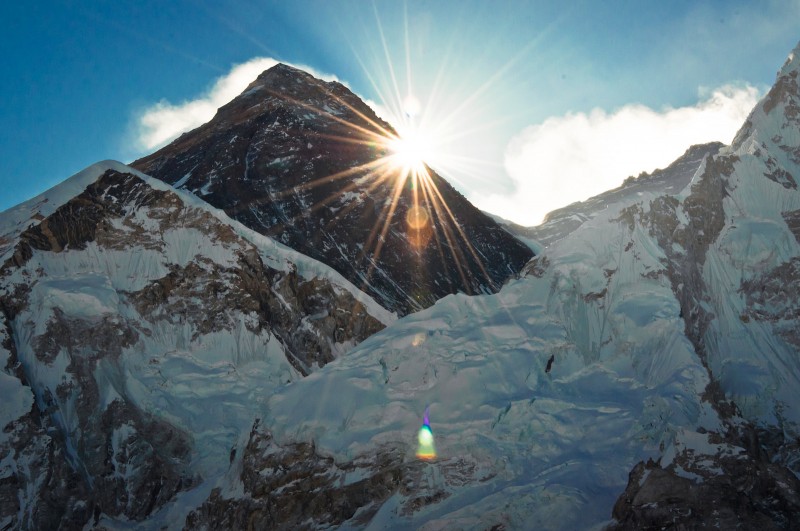For Nepal, a country roiled by political instability, Mount Everest is a source of national identity and pride. At this moment in time, that pride is at an all-time low.
From pristine to down-right scummy, Everest's landscape has changed a great deal over the last half-century, and climbing the peak is now a greater health hazard than ever before.
Media poop-scoops and indignant tweets offer an explanation as to why:
#MountEverest Deaths Not Only Thing That May Keep Climbers Away – http://t.co/9VmuCAmfto #humanwaste #Nepal pic.twitter.com/txJk0HOuFa
— Inquisitr News (@theinquisitr) March 4, 2015
From henceforth #MountEverest shall be known as Mount Pooperest. http://t.co/bawOH6ll99
— Kristina Proffitt (@KrissyProffitt) March 4, 2015
While rescuing stranded mountaineers was once the main concern in Nepal's high-altitude tourism sector, rescuing the mountain has now become the main focus. According to the BBC, advances in climbing technology and improvements in Nepal's mountain tourism have made it possible for more than 200 people to ascend to peak everest in a day with good weather, over five times the number able to do that thirty years ago. Suddenly, the roof of the world is getting crowded out.
Stop pooping on Mt. Everest, everybody. C'mon. http://t.co/3l9fpGEIj5pic.twitter.com/CWyMxyFAE8
— pourmecoffee (@pourmecoffee) March 3, 2015
How anyone could litter in such a pristine environment is beyond our comprehension. Global Gypsies Travel Club… http://t.co/B0mEVQTYvF
— Davina van Buren (@davinavanburen) March 4, 2015
In April 2014, an avalanche led to the tragic deaths of 16 Sherpa guides — a name taken from the ethnic group living in the area around the mountain, many of whom are employed by it — and the abandonment of climbing for that year, highlighting precarious safety conditions in Nepal.
This year, with mismanagement that has led to open defecation in snow, combined with the waste left behind by more than 5,000 ascents, there is a real danger of disease-spreading and contamination, which has seen Everest branded a fecal time bomb.
This is not only a problem for climbers but also for sherpas and their families whose main waterways are at risk.
According to the United Nations World Health Organisation (WHO), the improper disposal of fecal material is responsible for 4 percent of all deaths and 5.7 percent of all disability or ill-health in the world.
The situation on the mountain is also likely to cause a big dip in the number of future expeditions, threatening the sustainability of Nepal's tourist industry and the incomes of hundreds of Sherpa families.
In light of projected losses, the Nepali government has sought to attract foreigners back with a mixture of the carrot and stick, by slashing the price of climbing in the first part of 2015 but also targeting tourists with fines if they do not return with their rubbish.
This latter mechanism has been in place since 2010 but not everyone agrees that it is effective:
Leo Schilts, a commentator on an article written by the Guardian commented:
Anyone who has been to Nepal will know that the piles of filth and excrement everywhere are not caused by tourists. […]Fining tourists for the Nepali government's own failure is typical shameless profiteering from one of the most corrupt regimes in the world, 126 out of 175 in decending order on Transparency International's corruption perception index. Don't be fooled into imagining that money actually goes to remedying the problem. In the 60 years since development programs began in Nepal precisely nothing has been achieved except to enrich the corrupt and venal elite and devestate the cultural and natural environment.[…]The failure of governments in the region to provide even basic levels of sanitation, the unchecked pollution and wholesale destruction of natural and built environments which results in the preventable deaths of hundreds of thousands every year from water born diseases, air pollution and food contamination… I find it frustrating that the attention getting the headline here is the only one which finds the angle on the story of how this region wide emergency might slightly inconvenience the leisure activities of a few millionaires with enough money to afford the $70,000 plus cost for an Everest assent. It just seems massively self absorbed to me.
Moreover, many argue these rules are not implemented: despite cleaning expeditions carried out by teams including that of Apa Sherpa, a local man who climbed Mount Everest for the 21st time in May 2011, it is estimated that at least 10 tons of waste remain on the mountain.
Yet, not all hope is lost.
Many, including climbers, have suggested ways to fix the situation, including fewer permits, smaller expeditions and restrictions based on experience.
Moreover, the Head of the Nepal Mountaineering Association has confirmed that from here onwards officials stationed at base camp will be monitoring the garbage on the mountain more strictly than they have in previous years.
The Everest climbing season begins this week and will continue through May. With around 700 climbers expected, the famous mountain's guardians will be under pressure to make good on their promise.







